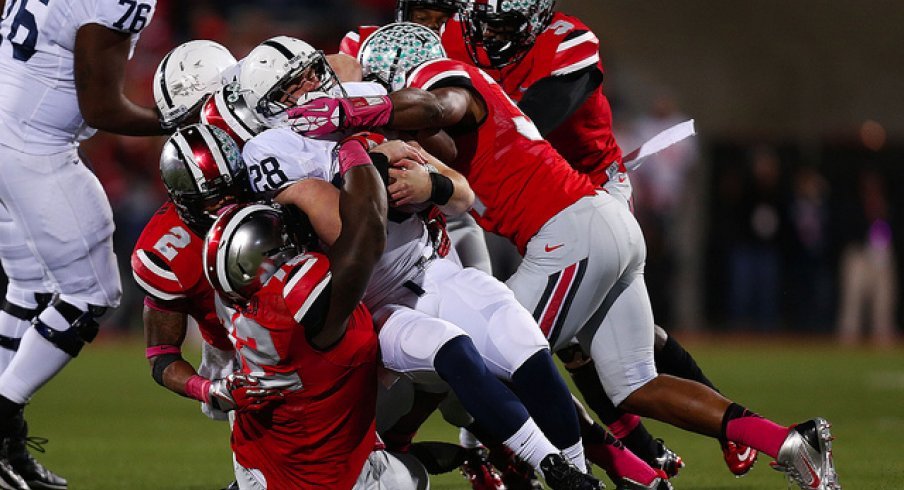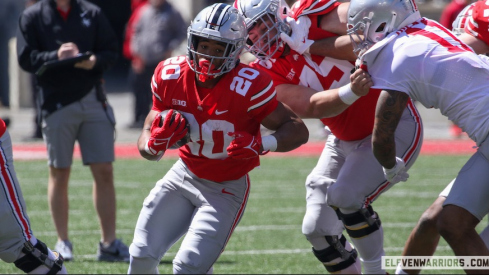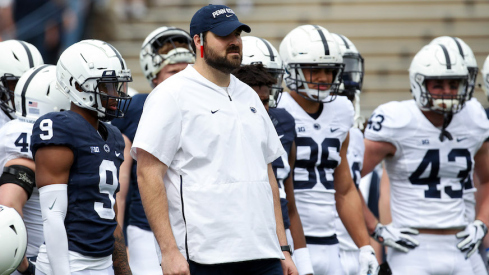Penn State’s 2015 season has been marred by offensive inconsistency and protection issues, resulting in the O-line giving up a record 10 sacks in an opening season 27-10 loss to Temple.
With Big Ten all-freshman wide receiver DaeSean Hamilton unable to repeat his 2014 catch numbers thus far, the Lions lack an explosive offensive playmaker — resulting in a unit that struggles to string together drives and create explosive plays. The Nittany Lions currently rank 13th in the Big Ten in total offense (344 yards per game) and are last place in first down percentage (31 percent).
Head coach James Franklin has married Penn State’s traditional pro-style offense with the spread concepts he ran at Vanderbilt. The unit runs an interesting mix of spread concepts such as the zone blocking scheme (ZBS), run-pass options (RPO), screens, and four receiver sets, while still maintaining the unit’s tradition of heavy personnel formations utilizing multiple running backs and tight ends.
It isn’t uncommon to see quarterback Christian Hackenberg huddle and take a snap under center, then rush to the line and take the next snap out of the shotgun in a “check with me” play call (coach signals in the play from the sideline after the offense is aligned).


Although Franklin has stated his scheme should ideally run an even run-pass ratio, a lack of consistent talent at the skill positions have forced offensive coordinator John Donovan to plan and call conservative games in order to keep the offense out of negative situations. Until a reliable option emerges in the pass game, this team will continue to be a run-first squad.
Penn State’s surprise player of the season has been 5-foot-11, 220-pound true freshman RB Saquon Barkley, who introduced himself to college football fans with a 12-carry, 115-yard effort against Buffalo. With Barkley carrying the ball the Penn State offense has put up its three highest point totals of the season in victories over Buffalo (27-14), Rutgers (28-3), and San Diego State (37-21).
After missing the previous two-and-a-half games due to a lower leg injury, the offense eagerly anticipates his return to action. It appears Barkley will be a go Saturday night as Franklin previously alluded to the talented youngster being held out of the Indiana game in order to be 100 percent against the Buckeyes.
The explosive Barkley provides the combination of speed, power, vision and decisiveness needed to move the chains and create chunk plays in the running game, a skill set the often-stagnant Penn State offense desperately lacks.
Buffalo was the recipient of Barkley’s first “wow” play of the season out of 21 personnel when the Penn State offense dialed up an Ohio State favorite, the boundary Counter Trey off jet motion.

Although the jet motion looks like window dressing, it is actually vital component of the play concept by forcing the defense to adjust in two important ways. First, the jet motion changes the cornerback’s run fit so he must play as “secondary force” near the line of scrimmage. Corners are generally the weakest-tackling defenders on the field, and the goal is to force them to take down the ball carrier in space.
More importantly the jet motion forces the strong safety (SS) and strong-side linebacker (SAM) to bump their run fits (gap they are responsible for) AWAY from the counter, effectively taking both out of the play. While watching the play notice their aggressive downhill attack towards the line of scrimmage away from the ball.

Following great blocks from the right guard and fullback, Barkley presses the B-gap with authority. At the second level Barkley takes the play from good to great, displaying his natural athleticism to leap over the diving FS and keeping his feet for another 10 yards.
Against Rutgers the true freshman showed off his vision, patience, decisiveness and power in the open field off a variation of the Pin-and-Pull Sweep, another OSU favorite.

The offense operates out of 22 personnel, a heavy look often used to outnumber the defense at the point of attack (POA) by outnumbering run defenders with blockers. The backs are lined up in an Offset-I with the tight ends aligned in a Tight-Wing formation. Four position players aligned to a single side of the field (the ball is going that way) is often an offensive play direction tendency that we will see in action here.
A nuance to look for in the Penn State run game is backside cut blocking on outside running plays. In the film below, focus on the left tackle cutting the 4-i defensive end. The Buckeyes' defensive line will need to stay low and use their hands to push off the block before it can get into their legs if they hope to pursue outside runs from the backside.
Watch Barkley press the line of scrimmage at the first opportunity, following the old coach’s adage, “Speed through the hole, not speed to the hole.” His outstanding patience and vision is displayed as he waits for the pulling center (No. 66) to get to his block on the middle linebacker (MIKE).
As you can see from the film, he anticipates the hole that will be created by the blocking angle and makes his cut just before the block happens. Once the cut is made there is no dancing, only straight downhill running to the end zone. Barkley then demonstrates his ability to break tackles in the open field as he powers through three arm tackles on the way to the end zone.
Later in the Rutgers game Barkley again demonstrates his decisive, downhill running style as he hits the C-gap with square shoulders and runs through a weak ankle tackle by the free safety on the way to a 17-yard score.

With second leading rusher Akeel Lynch questionable for the OSU matchup as well, the Nittany Lions may be forced to put the rushing game in the hands of unproven freshmen Nick Scott and Mark Allen.
If Barkley and Lynch are scratches this Saturday, the pressure will fall on a player well-known to NFL Draft pundits, the 6-foot-5, 235-pound junior, Christian Hackenberg.
The potential first round draft pick has experienced a rollercoaster career trajectory since his breakout freshman season in which he completed 58.9 percent of his pass and tossed 20 touchdowns. After a strong freshman year, Hackenberg regressed with a sophomore campaign that saw him throw more interceptions than touchdowns (15-12). Although the signal-caller has cut down his turnovers this year, he is completing a career-low 53 percent of his passing attempts.
There is no denying Hackenberg’s measurables. He possesses the size and arm strength coveted by NFL scouts and general managers. Hackenberg slides well in the pocket for a quarterback his size, and NFL teams will love his experience in a pro-style offense. He has all the tools to make special throws, but like the unit he leads, inconsistency has plagued him during his three seasons at Penn State.
Hackenberg’s decision making can be very suspect, as his habit of forcing balls into tight windows leads to turnovers, particularly when pressured. His mechanics can be lazy at times as he often throws flat-footed. This breakdown in fundamentals partially explains his low career completion percentage of 56.5 percent.
Although capable of reading through multiple progressions, Hackenberg will often lock on to his primary receiver at the snap of the ball as he does below, leading to easy pass breakups and interceptions for the defense.


Hackenberg has had to work through his share of adversity at Penn State. His pass protection as been abysmal; he was sacked an FBS record 44 times last season. He has dealt with a head coach change and a lack of reliable talent at the skill positions.
After putting up 420 total yards and scoring four touchdowns in a 29-7 home victory over Indiana, Hackenberg will enter the Horseshoe riding a wave of confidence after his early season struggles.
The Penn State offense wants to take shots downfield off play action. Like a boxer who forces his opponent to lean left before unleashing a right, a well-designed offense will set up a defense with base plays and constrain them when they overcompensate. Penn State is no different as they will run a variety of play action packages to complement their run-heavy offense, and then constrain teams that overplay the run game.
The constraint theory relies on several base plays the offense has proven they can successfully execute. During Week 2, the squad ran a jet sweep off an inside zone fake with speedy receiver Brandon Polk (No. 10). The right defensive end (No. 91) squeezed inside to play the dive, leaving the edge clean for Polk to turn upfield. With the help of solid perimeter blocking, the diminutive wide receiver takes it to the house.

Fast forward to week five against Indiana. The offense uses the same inside zone fake, but also fakes the jet. Knowing that the successful jet sweep run in Week 2 against Buffalo is on tape and has been scouted by Indiana, OC John Donovan correctly guesses the Hoosier’s boundary safety is likely to come downhill hard to his run fit when he sees the jet motion. Donavan uses this overaggressive play to slip a post route behind him, leaving the cornerback in single coverage against all-Big Ten freshman Team wide receiver DeaSean Hamilton.


Hackenberg throws an outstanding ball to hook up with Hamilton for the touchdown.
Against Army, Donovan dialed up another creative play action concept that resulted in a 35-yard touchdown. The offense is showing a run-heavy tendency here with 12 personnel on the field. The idea is to influence the linebackers and defensive backs who are likely thinking "run" due to alignment, and then hit them overtop if they practice poor eye discipline.

The OL sells the play action by pulling the guard away from the route combination. Teams will often pull linemen and use a form of slide protection to face key defenders (linebackers are often taught to key the guard for run/pass and play direction) and protect the quarterback as the routes develop downfield. Notice how hard both interior linebackers attack their run fits. They have bought the play action hook-line-and-sinker.
Hackenberg appears to quickly recognize the hole in the defense, looks off the safety, and comes back to the route with a confident throw for six.
Donovan adds a clever subtle twist to the concept by delaying the release of the strongside tight end at the top of the screen, allowing the twin wide receivers to clear out the deep defenders. This forces the SAM (No. 21), or strong-side linebacker, to choose between the routes run by the tight end or running back. This vertical stretch is known as a hi-lo and is the basis of many classic concepts including Sail, Drive, and Snag.

To complement their inside run game and move defenders out of the box, the Penn State offense will target the perimeter of the field with a variety of Bubble and Now screens, as well as RPO concepts.
During the 2014 matchup, the offense attacked Darron Lee’s inside leverage over the slot wide receiver by throwing a bubble screen. To create numbers at the line of scrimmage PSU used motion to move a third receiver to the wide-side of the field. His job was to stalk block Lee, which was made easier by the blocking angle the motion created. While not perfect, the blocker forced Lee to cut inside the ball, allowing the receiver to take the edge.

Like Ohio State, Penn State will swing the ball on designed throws to the running back when they spot a numbers or matchup advantage.
 Count up the number of defenders and blockers to the left side of the ball within five yards (count the center). Due to the defense’s alignment, the offense can create an east five on four matchup by throwing a quick flat route to the running back. This is like stealing for Hackenberg.
Count up the number of defenders and blockers to the left side of the ball within five yards (count the center). Due to the defense’s alignment, the offense can create an east five on four matchup by throwing a quick flat route to the running back. This is like stealing for Hackenberg.
Because the O-line has shown serious protection issues, particularly early in the season, the offense will often use the quick game to get the ball out of Hackenberg’s hands. Here the offense goes to an OSU staple, the man-beating Double Slants concept.

Hackenberg displays his outstanding arm strength, firing the ball into a narrow slant window between two defenders for a 1st down completion.
Penn State again uses the quick game to get the ball out of Hackenberg’s hands and stress the defense using an RPO concept seen at all levels of football.

The read man is No. 3, cornerback Josh Jenkins. Hackenberg’s read is straightforward. If Jenkins fits inside to play the run, throw the screen as both defenders will be blocked. If Jenkins honors the screen motion, give to the running back on inside zone as there is now no backside edge defender.
 Hackenberg again makes the correct read for any easy touchdown to DaeSean Hamilton.
Hackenberg again makes the correct read for any easy touchdown to DaeSean Hamilton.
Stopping the run and play action passing game starts with reading keys. As we have discussed in previous articles, perimeter players will look to the end man on the line of scrimmage (EMLOS) for a hi-hat/lo-hat read.

Interior players will generally read the guard for run/pass (hi-hat/lo-hat) and play direction keys. (Does the guard down block? Reach block? Pull?) Although the guard key can be slow developing, it is rarely wrong unless manipulated by a smart offensive coordinator.

In a game that was competitive last season the difference between a win and a loss can come down to a simple detail. Who will make the game-changing mistake? Who will take advantage of it? Tune in Saturday and we’ll find out together.


